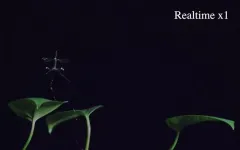(Press-News.org) Published in the journal Food Quality and Preference, the research highlights how physiological signals, particularly those transmitted via the vagus nerve, interact with socio-economic factors to shape dietary behaviour.
The study involved 96 students from diverse socio-economic backgrounds who participated in a chocolate tasting session.
In a controlled laboratory setting, each participant was presented with a plate containing 70 milk chocolate pieces and invited to sample and rate them at their leisure.
Researchers measured each student's heart rate variability (HRV) as a proxy for the activity of the vagus nerve – a part of the nervous system that regulates appetite and digestion.
The study’s lead author, Professor Mario Weick of Durham University’s Department of Psychology, explained: “The findings suggest that while the vagus nerve plays a key role in transmitting signals between the gut and the brain, the extent to which these signals guide eating behaviour can vary with one’s socio-economic status.
“Our research indicates that internal signals may be more closely aligned with eating behaviour in individuals from higher socio-economic backgrounds.
“In contrast, those from lower socio-economic groups appear to show a weaker link between these physiological signals and their food consumption.”
The research builds on longstanding theories regarding the impact of socio-economic factors on health and dietary habits.
Traditionally, disparities in diet have been attributed to differences in food access and external factors.
However, this study shifts the focus towards internal regulatory processes.
The data revealed that participants from more advantaged backgrounds consumed more or less chocolate depending on their vagal tone, which can signal both hunger and satiety.
Conversely, in individuals from less advantaged backgrounds, this physiological regulation was not as evident.
Professor Milica Vasiljevic of Durham University, the study’s co-author added: “Our study does not support the idea that individuals from lower socio-economic groups eat more or are inherently more impulsive.
“Rather, it highlights that the internal regulation of eating - how our bodies naturally signal when to eat and when to stop - may function differently depending on our socio-economic backgrounds.
“This could have important implications for understanding broader health inequalities.”
While the research focused specifically on chocolate consumption as a model for eating behaviour, the implications may extend to other types of food and dietary patterns.
Future research is needed to explore whether similar patterns are observed across different populations and with other food categories.
This work marks a significant step forward in disentangling the complex relationship between socio-economic status, physiological regulation, and dietary habits.
By bringing attention to the role of internal bodily signals in shaping eating behaviour, the research offers new perspectives for developing public health strategies that address dietary inequalities and associated long-term health outcomes.
END
New research reveals socio-economic influences on how the body regulates eating
2025-04-16
ELSE PRESS RELEASES FROM THIS DATE:
Unhealthy metabolic profile sharply increases risk of breast cancer returning and subsequent death from breast cancer among those who have survived the disease
2025-04-16
New research to be presented at this year’s European Congress on Obesity (ECO 2025, Malaga, Spain, 11-14 May) and published in The Journal of Internal Medicine shows that, in survivors of breast cancer, having an unhealthy metabolic profile or so called ‘metabolic syndrome’ increases the risk of breast cancer recurrence by 69%, and subsequent breast cancer mortality by 83%. The study is by Dr Sixten Harborg, Department of Oncology, Aarhus University/Aarhus University Hospital, Aarhus, ...
Marine radar can accurately monitor vessel speeds to protect whales, study finds
2025-04-16
A new study by researchers at ProtectedSeas highlights the potential of marine radar technology to monitor speed of small vessels. The research, aimed at testing the accuracy of radar in assessing potential violations, found that the technology could detect speed violations with 95% confidence, offering a promising solution to help reduce the threat of vessel strikes on whale populations. The analysis was recently published in the journal Sensors.
The impact of small vessels on whales is becoming a growing concern in busy marine environments due to the increasing number ...
National Center to Reframe Aging teams up with West End Home Foundation
2025-04-16
The National Center to Reframe Aging — the leading organization for proven communication strategies and tools to effectively frame aging issues — is partnering with The West End Home Foundation (WEHF), an independent charitable foundation located in Nashville, Tennessee.
The National Center to Reframe Aging will be a strategic partner to support the WEHF’s mission to enrich the lives of older people through grant making, advocacy, and community collaboration. Key leaders of the Tennessee Department of Disability and Aging and the Tennessee aging network will participate in educational opportunities and receive tools from the National Center ...
How do age, sex, hormones and genetics affect dementia biomarkers in the blood?
2025-04-16
EMBARGOED FOR RELEASE UNTIL 4:00 P.M. ET, WEDNESDAY, APRIL 16, 2025
MINNEAPOLIS — A new study has found important clues about the roles age, sex, hormonal changes and genetics play in how certain biomarkers for dementia are expressed in the blood, according to a study published on April 16, 2025, online in Neurology®, the medical journal of the American Academy of Neurology.
“Blood tests that detect biomarkers for Alzheimer's disease and other dementias are emerging and as these tests are further developed, they are becoming important tools for understanding and diagnosing ...
NSF NOIRLab astronomer discovers oldest known spiral galaxy in the Universe
2025-04-16
Large, grand-design spiral galaxies like our own Milky Way are common in the nearby Universe. But they have proven hard to find in the early Universe, which is consistent with expectations that large disks with spiral arms should take many billions of years to form. However, assistant astronomer Christina Williams of NSF NOIRLab, which is funded by the U.S. National Science Foundation, has discovered a surprisingly mature spiral galaxy just one billion years after the Big Bang [1]. This is the most distant, earliest known ...
Iron Age purple dye "factory" in Israel was in operation for almost 500 years, using mollusks in large-scale specialized manufacturing process
2025-04-16
Iron Age purple dye "factory" in Israel was in operation for almost 500 years, using mollusks in large-scale specialized manufacturing process
Article URL: https://plos.io/44elLDX
Article title: Tel Shiqmona during the Iron Age: A first glimpse into an ancient Mediterranean purple dye ‘factory’
Author countries: U.S., Israel
Funding: The author(s) received no specific funding for this work. END ...
Even vegans who get enough total protein may fall short for some essential amino acids
2025-04-16
In a new study of people with long-term vegan diets, most ate an adequate amount of total daily protein, but a significant proportion did not meet required levels of the amino acids lysine and leucine. Bi Xue Patricia Soh and colleagues at Massey University, New Zealand, present these findings in the open-access journal PLOS One on April 16, 2025.
Proteins are made up of various molecular “building blocks” known as amino acids. While the human body can synthesize most of the amino acids we need to live, we completely rely on the ...
RoboBee comes in for a landing
2025-04-16
The Harvard RoboBee has long shown it can fly, dive, and hover like a real insect. But what good is the miracle of flight without a safe way to land?
A storied engineering achievement by the Harvard Microrobotics Laboratory, the RoboBee is now outfitted with its most reliable landing gear to date, inspired by one of nature’s most graceful landers: the crane fly.
Publishing in Science Robotics, the team led by Robert Wood, the Harry Lewis and Marlyn McGrath Professor of Engineering and Applied Sciences in the John A. Paulson School ...
“Ban-the-Box” policy did not effectively help job applicants with criminal records in one analysis
2025-04-16
Analysis of job applicant data from one large employer suggests that a policy meant to improve employment prospects for people with criminal records did not actually lead to changes in job offers for people with records. Deborah Weiss of Northwestern University, U.S., and colleagues present these findings in the open-access journal PLOS One on April 16, 2025.
Parts of the U.S. have introduced “Ban-the-Box” (BTB) laws, which aim to improve job prospects for people with criminal records. ...
Sunscreen, clothes and caves may have helped Homo sapiens survive 41,000 years ago
2025-04-16
ANN ARBOR—Ancient Homo sapiens may have benefitted from sunscreen, tailored clothes and the use of caves during the shifting of the magnetic North Pole over Europe about 41,000 years ago, new University of Michigan research shows.
These technologies could have protected Homo sapiens living in Europe from harmful solar radiation. Neanderthals, on the other hand, appear to have lacked these technologies and disappeared around 40,000 years ago, according to the study, published in Science Advances and led by researchers at Michigan Engineering and the U-M Department of Anthropology.
The team found ...





